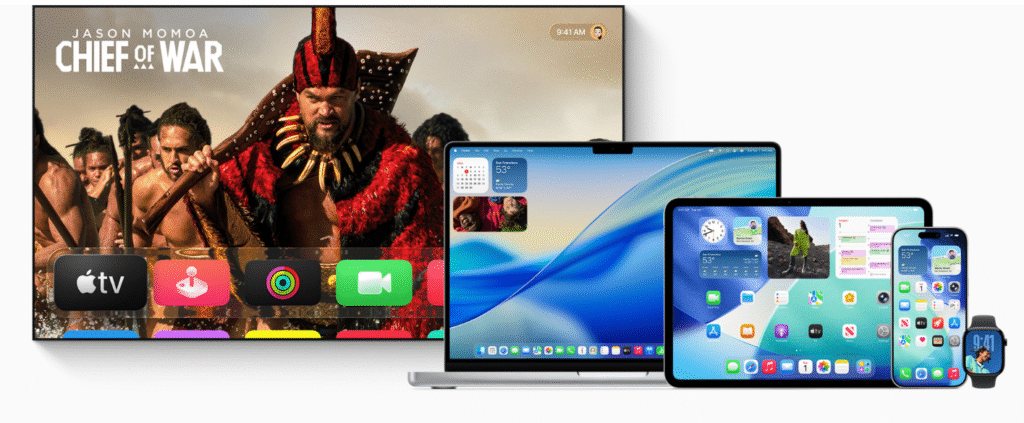macOS Tahoe (macOS 26) lands on September 15, 2025. Learn the macOS Tahoe release date, new Liquid Glass design, Spotlight overhaul, compatibility, and install tips.
Dateline: Monday, September 15, 2025 — Apple has released macOS Tahoe (macOS 26) to the public. The update brings a major visual refresh, several new productivity features, and tighter continuity with iPhone and iPad updates rolling out the same day.

macOS 26 release date & why it matters
- macOS Tahoe release date: September 15, 2025.
- Marketing name/version: macOS Tahoe, internally versioned as macOS 26.
- Big theme: “Liquid Glass” — a transparency-forward design and systemwide polish.
- Notable changes: redesigned visuals, the largest Spotlight upgrade in years, a Phone app for continuity, Live Activities on Mac, clipboard history, and expanded Apple Intelligence features.
- Compatibility note: Apple says this is the last major macOS to support many Intel Macs; future releases will target Apple Silicon.
This short list hits the headlines. Below you’ll find full details, useful tips, and what reviewers are saying.
What’s new in macOS Tahoe?
Liquid Glass: a visual rethink
Tahoe’s most visible change is its new Liquid Glass design language. Icons, windows, and widgets use more translucency, rounded edges, and subtle depth. The aim is consistency with the iPhone and iPad refresh in 2025. The look is cleaner and more modern, but some users will need time to adapt.
Spotlight — bigger and smarter
Apple calls this the biggest Spotlight update in years. Search is faster and more actionable. Results come with new inline actions. You can run quick tasks, see richer previews, and use better natural-language queries. This change is aimed at power users and everyday search alike.
Continuity improvements — Phone app, Live Activities
Tahoe adds a native Phone app and brings Live Activities to the Mac. You can continue calls and view live information from your iPhone directly on a Mac. This continues Apple’s strategy of tighter ecosystem integration.
Productivity upgrades and Apple Intelligence
Shortcuts, Reminders, and native apps receive smarter options. Apple Intelligence features expand—suggested actions, system-wide quick reminders, and better context-aware suggestions help speed workflows. Clipboard history and improved Finder/folder customization are small but welcome wins for daily use.
Gaming and apps
A new Games app appears across Apple platforms. macOS Tahoe also improves support for cross-device experiences and adds subtle performance boosts for Apple Silicon chips. Apple positioned some features to help developers bring more games and richer apps to the Mac.
macOS Tahoe release date — specifics you should know
Apple announced at WWDC on June 9, 2025, that macOS Tahoe would arrive later in the year, and the company confirmed the public launch for September 15, 2025. The update rolled out globally through System Settings, with downloads becoming available around 10:00 a.m. PT on launch day for most users.
If you follow the public beta program, you may have seen release candidates before today. But if you’re on a stable channel, the official installer appears now in System Settings → General → Software Update.
Will your Mac run macOS Tahoe?
Apple’s compatibility list is always the first stop. Tahoe supports a broad range of Macs, but keep these points in mind:
- Most Apple Silicon Macs are supported.
- Selected Intel Macs remain supported for this release — but Tahoe is expected to be the last major macOS version to support Intel-based Macs. If you rely on an Intel machine, plan upgrades carefully.
Before upgrading, check Apple’s official compatibility page (System Settings → Software Update will show eligibility). If your Mac is older and currently on Intel, weigh the benefits against potential performance or driver issues for specialized hardware.
How to prepare for the macOS Tahoe update
- Back up now. Use Time Machine or another backup method. Upgrades can go smoothly, but backups are cheap insurance.
- Check apps for compatibility. Especially third-party apps that use kernel extensions or custom drivers. Many developers pushed updates during beta.
- Free up space. Major macOS upgrades often need tens of gigabytes of free space for download and temporary files.
- Plan downtime. Even on fast machines, the full update and post-install setup can take 30–60 minutes.
- Update firmware and SMC for Intel Macs. If your Mac is Intel-based, check for firmware updates from Apple before upgrading.
Tom’s Guide and MacRumors published practical step-by-step checklists on upgrade day that many readers found useful.
Early reactions: praise and caveats
Reviewers highlight the visual overhaul and Spotlight upgrade as the biggest wins. Many say that Liquid Glass feels fresh. Productivity fans appreciate clipboard history and the Phone app integration. However, reactions are mixed:
- Some users report that the new visual effects increase system indexing and memory usage on older hardware. Expect slower performance on very old machines or those with limited RAM.
- Designers and long-time macOS users debate whether the aesthetic gains justify the change in visual language. Taste will vary.
If you want stability over novelty, some commentators advise waiting a few weeks for early updates and third-party app patches. If you want the new features now, upgrading on day one is reasonable for most modern Macs.
Practical tips for everyday users
- Use the new Spotlight features to replace some third-party launcher apps.
- Try the clipboard history for copy/paste-heavy tasks. It can save a surprising amount of time.
- If you rely on specialized audio or video hardware, check vendor notes before updating. Some drivers need a patch.
- Sign in to iCloud and enable Continuity features to experience the Phone app and Live Activities fully.
Is macOS Tahoe worth it?
For most users with compatible hardware, macOS Tahoe (macOS 26) is a solid evolutionary update. It’s visually distinct and adds productivity features that matter day-to-day. The Spotlight overhaul and deeper iPhone–Mac continuity are practical improvements. If you run older Intel hardware or depend on niche drivers, proceed with caution and prepare backups